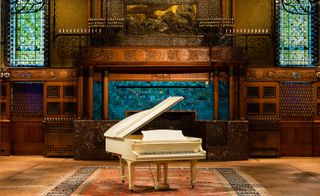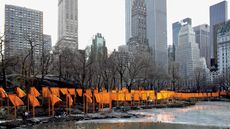Back door policies: Martin Creed's survey at the Park Avenue Armory

Martin Creed is a born multi-tasker. ‘I often think that if I’m trying to do a drawing or a painting or any kind of work, it’s like trying to narrow the world down to this one thing,’ says the British artist at a press preview for his exhibition at New York’s Park Avenue Armory. ‘It seems to me very artificial, because life is not like that. Life is all mixed up and all over the place.’ The same can be said of the sprawling survey—in the best possible way.
On view through 7 August, 'The Back Door' takes its name from Creed’s characteristically singular intervention in the Armory’s cavernous drill hall, the site of gargantuan installations past. ‘Martin and I stood there in the absolute dark, and we noticed the back door of the drill hall,’ said Tom Eccles, who curated the exhibition with Hans-Ulrich Obrist. ‘We opened and closed it, opened and closed it, and had this extraordinary experience of opening the Park Avenue Armory to one of the most democratic streets on the Upper East Side—the Lexington Avenue side.’
Creed has seized upon the building’s eastern aperture as a visual palette cleanser. The raising and lowering of the door’s metal shutters – and the dynamic snippet of city life they momentarily reveal – bracket a series of six video portraits, none longer than three minutes, in which the camera (slowed to one-eighth speed) zooms in on the unsmiling face of a woman (including model-turned-actress/entrepreneur Lily Cole), who ultimately parts her lips to reveal a mouthful of goo. The central space is empty save for the projection screen, a few spindly wooden benches, and the sporadic appearance of a troupe of roving musicians led by a megaphoned singer of Creed’s infectious melodies.
Elsewhere, Creed works both old and new, each titled tidily with a number, infiltrate the Armory, which is still in the throes of a $210-million room-by-room renovation masterminded by Herzog & de Meuron. A trio of metronomes marks times in one of the historic period rooms, while another is stuffed with the large white balloons of Work No. 360: Half the air in a given space (2015). In the parlour, the lights turn on and off, at one-second intervals, while one corridor is framed by velvet curtains that continually part and then come back together.
In a nod to the chaos of reality, Creed’s works mix and mingle with the Armory’s historic artefacts: here a grandfather clock pushed into the hall and set askew, there a wall-mounted elk head eying a shelf of newly arrived cactuses (Work No. 2376) with suspicion. Crumpled-paper balls and precisely stacked cardboard boxes are joined in glass cases by trophies awarded to outstanding cadets in the ‘Knickerbocker Greys’ youth corps or commemorating the victors of ‘indoor baseball’ competitions. Not surprisingly, Creed bristles at the ‘goals and rules’ that define sports. ‘What people call art, I don’t think it has a really clearly defined goal,’ he says, and then picks up to his guitar to elaborate with a song.

'The Back Door' takes its name from Creed’s characteristically singular intervention in the Armory’s cavernous drill hall (pictured), the site of gargantuan installations past

Creed works both old and new, each titled tidily with a number, infiltrate the Armory, which is still in the throes of a $210-million room-by-room renovation masterminded by Herzog & de Meuron. Pictured: Work No. 569, Piano (2006)

The works mix and mingle beautifully with the Armory’s own arsenal of historic artefacts

A trio of metronomes (pictured left) mark time in one of the historic period rooms, while a pyramid of chairs (right) holds court in another
INFORMATION
Martin Creed’s ’The Back Door’ is now on view until 7 August. For more details, please visit the Park Avenue Armory’s website
Photography: James Ewing. Courtesy of Park Avenue Armory
ADDRESS
Park Avenue Armory
643 Park Avenue
New York, New York
Wallpaper* Newsletter
Receive our daily digest of inspiration, escapism and design stories from around the world direct to your inbox.
Stephanie Murg is a writer and editor based in New York who has contributed to Wallpaper* since 2011. She is the co-author of Pradasphere (Abrams Books), and her writing about art, architecture, and other forms of material culture has also appeared in publications such as Flash Art, ARTnews, Vogue Italia, Smithsonian, Metropolis, and The Architect’s Newspaper. A graduate of Harvard, Stephanie has lectured on the history of art and design at institutions including New York’s School of Visual Arts and the Institute of Contemporary Art in Boston.
-
 Revolutionary Apple icon designer Susan Kare unveils a playful jewellery and objet collaboration with Asprey Studio
Revolutionary Apple icon designer Susan Kare unveils a playful jewellery and objet collaboration with Asprey StudioAsprey Studio's new collection, Esc Keys, brings digital artworks by Susan Kare to life
By Hannah Silver Published
-
 What is the role of fragrance in contemporary culture, asks a new exhibition at 10 Corso Como
What is the role of fragrance in contemporary culture, asks a new exhibition at 10 Corso ComoMilan concept store 10 Corso Como has partnered with London creative agency System Preferences to launch Olfactory Projections 01
By Hannah Tindle Published
-
 Jack White's Third Man Records opens a Paris pop-up
Jack White's Third Man Records opens a Paris pop-upJack White's immaculately-branded record store will set up shop in the 9th arrondissement this weekend
By Charlotte Gunn Published
-
 20 years on, ‘The Gates’ makes a digital return to Central Park
20 years on, ‘The Gates’ makes a digital return to Central ParkThe 2005 installation ‘The Gates’ by Christo and Jeanne-Claude marks its 20th anniversary with a digital comeback, relived through the lens of your phone
By Tianna Williams Published
-
 In ‘The Last Showgirl’, nostalgia is a drug like any other
In ‘The Last Showgirl’, nostalgia is a drug like any otherGia Coppola takes us to Las Vegas after the party has ended in new film starring Pamela Anderson, The Last Showgirl
By Billie Walker Published
-
 ‘American Photography’: centuries-spanning show reveals timely truths
‘American Photography’: centuries-spanning show reveals timely truthsAt the Rijksmuseum in Amsterdam, Europe’s first major survey of American photography reveals the contradictions and complexities that have long defined this world superpower
By Daisy Woodward Published
-
 Miami’s new Museum of Sex is a beacon of open discourse
Miami’s new Museum of Sex is a beacon of open discourseThe Miami outpost of the cult New York destination opened last year, and continues its legacy of presenting and celebrating human sexuality
By Anna Solomon Published
-
 Sundance Film Festival 2025: The films we can't wait to watch
Sundance Film Festival 2025: The films we can't wait to watchSundance Film Festival, which runs 23 January - 2 February, has long been considered a hub of cinematic innovation. These are the ones to watch from this year’s premieres
By Stefania Sarrubba Published
-
 What is RedNote? Inside the social media app drawing American users ahead of the US TikTok ban
What is RedNote? Inside the social media app drawing American users ahead of the US TikTok banDownloads of the Chinese-owned platform have spiked as US users look for an alternative to TikTok, which faces a ban on national security grounds. What is Rednote, and what are the implications of its ascent?
By Anna Solomon Published
-
 Architecture and the new world: The Brutalist reframes the American dream
Architecture and the new world: The Brutalist reframes the American dreamBrady Corbet’s third feature film, The Brutalist, demonstrates how violence is a building block for ideology
By Billie Walker Published
-
 Inside Luna Luna: the amusement park designed by artists lands in New York
Inside Luna Luna: the amusement park designed by artists lands in New York‘Luna Luna: Forgotten Fantasy’ – featuring rides by Basquiat, Lichtenstein, Hockney, Haring, and Dalí – has opened at The Shed
By Osman Can Yerebakan Published